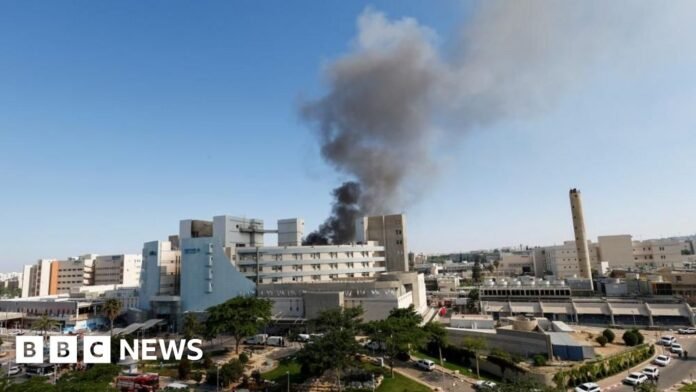Middle East correspondent
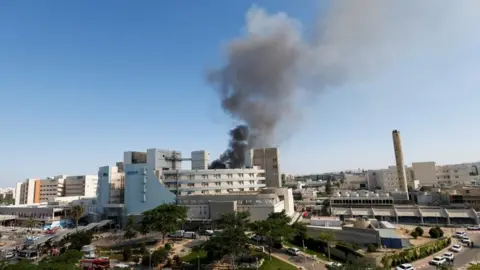 Reuters
ReutersBlack smoke was still billowing from the middle of the Soroka Medical Center when we arrived, several hours after Iran’s attack on the building.
Pieces of twisted metal shrapnel – some of it apparently from the missile itself – scattered across a 200m (656ft) area in and around the hospital complex.
Vehicles carrying medical staff lined the road outside – an emergency response to a situation that many had feared would be worse.
Crowds of soldiers, police and rescue teams milled around the hospital entrances, as a stream of ministers arrived to express their outrage at the strike.
Alon Uzi was wandering around outside the hospital entrance with two bags of belongings.
He said he had been receiving treatment in the emergency department when the attack happened, and didn’t have time to reach the shelter.
“I was lying in bed, and I heard a big boom,” he told us. “And before I could do anything, there was an explosion and part of the ceiling fell and I was covered with white dust.
“There was no time to get out of bed. I was just getting ready and then I heard a whistling noise.”
Inside the emergency reception area, the air carried the tang of chemicals mixed with dust. Patients were still being evacuated on stretchers from deep inside the building, as emergency teams passed through into the surgical wards that were hit.
Medical staff told local media that patients there had recently been moved to the hospital’s emergency shelters underground. Seventy-one people have been injured, according to Israel’s ministry of health.
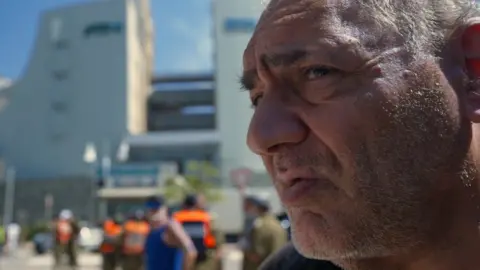
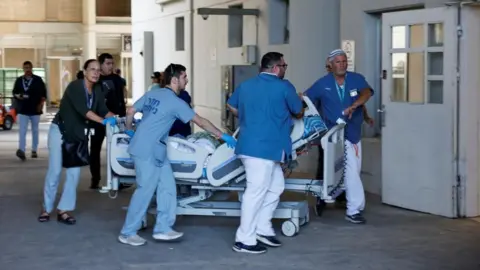 Reuters
ReutersProfessor Asher Bashiri, director of the maternity ward, said he could see the area of impact from his office.
“It looks unbelievable,” he told me. “The upper part of the building is cracked, and fire was coming from it in the first hours. Everything looks broken.”
He said they had moved all the patients to a more protected area when the war began.
“We were very, very lucky,” he said. “It could have been so much worse. But we are still living in an unbelievable situation. It’s not finished – I don’t know what will happen tomorrow, or the next day. We’re just happy that we’re alive.”
The hospital director, Shlomi Codish, said that the northern surgical building was hit and that several wards were demolished, with extensive damage to the entire hospital.
“We expect that we will be transferring over 200 patients in the next few hours to other medical centres,” he said. “We’re trying to minimise the number of people; we don’t know if buildings might collapse or if wards might collapse.”
Among the stream of ministers visiting the site today was Culture Minister Miki Zohar, from Prime Minister Benjamin Netanyahu’s Likud party.
“All the people need to know what we’re facing – a regime that is trying to kill innocent people,” he said. “When you’re dealing with evil, this is a different war. Believe me, we won’t stop until we win. We’re going to reply and it’s going to be very strong.”
Mr Zohar was asked about Israel’s history of bombing hospitals in Gaza – locations its army says are being used as military control centres by Hamas.
“We keep innocent people in Gaza safe as much as we can,” he said. “We call them to evacuate before we bomb. This is the big difference between Iran and us.”
Among the stream of ministers visiting the site today to express their outrage was Culture Minister Miki Zohar, from Prime Minister Benjamin Netanyahu’s Likud party.
“All the people need to know what we’re facing – a regime that is trying to kill innocent people,” he said. “When you’re dealing with evil, this is a different war. Believe me, we won’t stop until we win. We’re going to reply and it’s going to be very strong.”
Mr Zohar was asked about Israel’s history of bombing hospitals in Gaza – locations its army says are being used as military control centres by Hamas.
“We keep innocent people in Gaza safe as much as we can,” he said. “We call them to evacuate before we bomb. This is the big difference between Iran and us.”
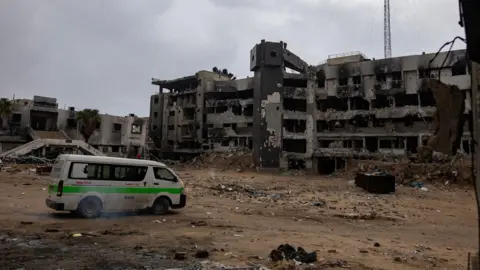 EPA
EPAIsrael’s Defence Minister Israel Katz accused Iran’s supreme leader of committing “war crimes of the most serious kind,” saying he would be held accountable.
Netanyahu has accused Iran of deliberately targeting civilians, promising that Israel will “exact the full price from the tyrants in Tehran”.
Iranian media says the centre they were targeting was at the Gav-Yam tech park, which is less than 3km (1.86 miles) away.
It was one of half a dozen sites hit by Iranian missiles on Thursday morning, a day after Donald Trump demanded Iran’s “unconditional surrender”.
It’s a reminder that both sides have the capacity to escalate this conflict, either by using different weapons – or by choosing different targets.
The US president is weighing up the decision to enter the war alongside Israel, while demanding that Iran submit to an agreement ending its nuclear enrichment, with the aim of blocking its path to a nuclear weapon.
On Wednesday, Israel said it sent 40 fighter jets to bomb targets in Iran, including an inactive nuclear reactor at Arak and a nuclear development building in Natanz, along with dozens of missile sites and radar.
After almost a week of daily attacks from both sides, this war is precariously balanced on the edge of a much wider conflict.



